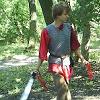Search the Community
Showing results for tags 'geometry'.
Found 7 results
-

[TIP] Almost a perfect fit
aeh5040 posted a topic in LEGO Technic, Mindstorms, Model Team and Scale Modeling
Here is an interesting little construction I stumbled upon. I post it in case it is useful to someone. The fit is not mathematically perfect, but very very close. The angle produced by the frames is 180 - 2 arctan(4/6) = 112.62 degrees, whereas the connectors are 112.5! What other constructions like this do you know? -

Straight tracks closer together than eight stud gap?
Tube Map Central posted a topic in LEGO Train Tech
The next project brewing in my head will be a place for my tube trains to call, two through tracks and side platforms. I would really like to be able to use 32 stud baseplates for this (four of them end to end). The question is, can I narrow the gap between long lengths of straight track, e.g four stud gap rather than eight, and easily bring them back to geometry at the ends, not necessarily using standard Lego curves/straights, and avoiding flexible track if possible? -

The Geometric Shape Generator
Jarema posted a topic in Digital LEGO: Tools, Techniques, and Projects
This is command-line tool for geometric shape manipulation and exporting as LDraw model. Typing this in command-line: LDShapeGenerator.exe --shape rectangular --geometry 1x2x5 --output C:\Windows\Temp\geometry-shape.ldr You got file with content like this: 0 Rectangular 0 Name: Rectangular 0 Author: LDShapeGenerator 1 27 20.0 24.0 20.0 1.0 0.0 0.0 0.0 1.0 0.0 0.0 0.0 1.0 3003.dat 1 27 20.0 24.0 60.0 1.0 0.0 0.0 0.0 1.0 0.0 0.0 0.0 1.0 3003.dat 1 27 20.0 48.0 20.0 1.0 0.0 0.0 0.0 1.0 0.0 0.0 0.0 1.0 3003.dat 1 27 20.0 48.0 60.0 1.0 0.0 0.0 0.0 1.0 0.0 0.0 0.0 1.0 3003.dat 1 27 20.0 72.0 20.0 1.0 0.0 0.0 0.0 1.0 0.0 0.0 0.0 1.0 3003.dat 1 27 20.0 72.0 60.0 1.0 0.0 0.0 0.0 1.0 0.0 0.0 0.0 1.0 3003.dat 1 27 20.0 96.0 20.0 1.0 0.0 0.0 0.0 1.0 0.0 0.0 0.0 1.0 3003.dat 1 27 20.0 96.0 60.0 1.0 0.0 0.0 0.0 1.0 0.0 0.0 0.0 1.0 3003.dat 1 27 20.0 120.0 20.0 1.0 0.0 0.0 0.0 1.0 0.0 0.0 0.0 1.0 3003.dat 1 27 20.0 120.0 60.0 1.0 0.0 0.0 0.0 1.0 0.0 0.0 0.0 1.0 3003.dat This tool using only basic regular bricks. Thanks, to this is 100% compatible with LEGO Digital Designer, BrickLink Stud.io and other digital tools that understand LDraw format. Repository: https://github.com/Jeremy1980/LDShapeGenerator/ Support Center -- go here if you have know more: https://github.com/Jeremy1980/LDShapeGenerator/wiki/ This is example of Cylinder; Trapezoid and three version of Rectangular prism -- 1x2x5 /look at the code above/ , 2x2x2 /knowed as cube/ , 2x5x1 /longest horizontal rectangle/:- 3 replies
-
- repository
- ldraw
-
(and 4 more)
Tagged with:
-
Hello all, in the last month I was working on three articles written in Hungarian language to use it as a standard for our train fan community. Last week I decided to translate it to English as well, and here it is for all those who needs advice on simply layouts, ideas for train station geometries and possible usages of Holger Matthes' long radius curves built from straight tracks. The three main sections of article (from original Hungarian articles) are the following: 1. Basic geometry rules and simple tricks - mostly based on Bill Ward's article on Brickpile, but including some own ideas 2. Station geometries - ideas for small, simple stations, station with through lines, building connections between parallel lines, using flextrack in 9V-setting, widening distance between tracks for platforms 3. Long radius curves built from straight tracks: ideas to use these not only in full loops, but at station geometries as well. Article contains URL to .bbm file as well to download it (made in BlueBrick version 1.8.1.). Article is at my Google Drive, since Brickshelf didn't allow me to upload in .pdf format: https://drive.google.com/file/d/0B2pGVpZyXf5hU3NYRWNuRkVCbHM/view?usp=sharing&resourcekey=0-HwAH24JRnsFAFtsowbF3cw
-
Astra Luminaria by Alysa Kirkpatrick, on Flickr Astra Luminaria is the biggest spaceship ever created by man. Built around Sirius B, the star, Astra Luminaria is the next technological advancement for humans to colonize other stars, and utilizing the star's energy to create long term survival in the ever increasing demand for more energy and space. Two rings orbit Astra Luminaria, built for the ever growing demand of space travel and life beyond the colonized ship. The rings allow for people look at the galaxies yet to be explored. Tech Specs: - diameter with other rings: 123 studs - diameter to outer shell: 101 studs - height: 131 studs - weight: 17 lb 11 oz - parts: 20,012 --------- I had a ton of fun building Astra Luminaria, my first SHIP. It is a hollow core SHIP with no technic. Both were something I really wanted to try out. The design is based on 4 nested spheres, which I then modified for better aesthetics. There is a light bulb in the center of it, giving it a really cool effect in the dark, (and makes photos looks a lot better). Let me know what you think Alysa
- 12 replies
-
- shiptember
- MOC
-
(and 3 more)
Tagged with:
-

45 Degrees in technic
Alien posted a topic in LEGO Technic, Mindstorms, Model Team and Scale Modeling
Hi everybody If been playing around with constructing at 45 degrees in technic and found the following techniques: The first one is using an axle through some connectors thus giving you 45 degrees and of course you can now start mounting or building of the axle: I also played around with the Pythagoras theorem and found the two practical values to use: 5 ( 6L in LEGO the first L is the 0 position ) and 7.071 { 5.sqrt(2) } rounded to 7 ( 8L in LEGO the first L is the 0 position ) 7 ( 8L in LEGO the first L is the 0 position ) and 9.899 { 7.sqrt(2) } rounded to 10 ( 11L in LEGO the first L is the 0 position ) The first Pythagoras pair used is the top left with the 6L black axle and the two no. 4 connectors. Not a fan of this method as it is a bit over sized and if you build the parts rigid into you construction with support from the top and the back of the no. 4 connector it might ever so slightly bend the axle or damage your parts. The second pair method one is the 11L beam again not a fan of this method as it will pull ever so slightly as it is actually a bit under sized. The second pair method two and most favoured by me personal is the one I like most yes there will be a small 0.1mm gap in the gray axle but it is really small. I like this method better because I can brace the no 4 connectors from the back and from the tops. I wanted to share this but also I would like to know if you guys have any other techniques you would like sharing? I would like to keep it stud less if possible. Of course using the new A plate with some technic bricks would also be a possibility: http://alpha.brickli...lor=11#T=C&C=11 Anton Edit 1:Used flickr deaplinks instead of attachments -

Geometry calculations for Linear Actuators
Countdown posted a topic in LEGO Technic, Mindstorms, Model Team and Scale Modeling
Hi community, Is there a resource available for calculating the kinematics of the LA's? Some kind of a computerized solver where you put a initial condition, the stroke of a cylinder, the length, the final angle of rotation or degree needed? Or some program to solve or simulate the kinematics of 3 and 4 point linkage? For example, here's my problem: I want to raise a boom from -10 to 90 deg. What would be the ideal configuration in studless with large LA's? Unfortunately, my laptop can't handle SR3D; is there something else? Thanks


